The Samsung Galaxy S7 and S7 edge Review: Part 2
by Joshua Ho on July 5, 2016 8:00 AM ESTCamera Architecture and UX
In general, camera has become probably the single biggest point of differentiation between smartphones at this point. As smartphones are often the only camera that most people carry on a day to day basis, the rear camera on a smartphone really cannot be a disappointment relative to the competition. While we can talk about how much a front-facing camera matters in terms of quality, it’s pretty safe to say that for photos and videos that are worth saving will be taken with the rear-facing camera.
While post-processing and a number of other factors are going to have a huge impact on the overall camera experience, the foundation that makes it possible to deliver a great camera is always going to start at the hardware.
| Samsung Galaxy S Cameras | ||||
| Galaxy S6 Galaxy Note5 |
Galaxy S7 | |||
| Front Camera | 5.0MP | 5.0MP | ||
| Front Camera - Sensor | Samsung S5K4E6 (1.34 µm, 1/4.1") |
Samsung S5K4E6 (1.34 µm, 1/4.1") |
||
| Front Camera - Focal Length | 2.2mm (22mm eff) | 2.1mm (21mm eff) | ||
| Front Camera - Max Aperture | F/1.9 | F/1.7 | ||
| Rear Camera | 16MP | 12MP | ||
| Rear Camera - Sensor | Sony IMX240 Samsung S5K2P2 (1.12 µm, 1/2.6") |
Sony IMX260 Samsung S5K2L1 (1.4 µm, 1/2.6") |
||
| Rear Camera - Focal Length | 4.3mm (28mm eff) | 4.2mm (26mm eff) | ||
| Rear Camera - Max Aperture | F/1.9 | F/1.7 | ||
In the case of the Galaxy S7, Samsung has done something that I thought they’d never do, which is move backwards in resolution in order to improve pixel sensitivity. In the case of the Galaxy S7, Samsung has moved from the Sony IMX240/Samsung S5K2P2 to the Sony IMX260/Samsung S5K2L1 sensor, with a 1.4 micron pixel size relative to a 1.12 micron pixel pitch in the previous generation. This means that there’s a 56% increase in sensitivity per pixel. Assuming the same process technology, this does improve low light performance significantly. While to some extent it’s true that improved CIS (CMOS image sensor) technology can alleviate the downsides of smaller pixels, on the same technology you have to reduce your fill factor/active sensor area. The other problem is that while read noise on the sensor does reduce per pixel as you reduce pixel size, the overall sensor read noise trends upwards. This means that the region in which the CIS noise is primarily limited by shot noise is going to be smaller as you reduce pixel size. Shot noise is an unavoidable reality of existence, to the extent that even our eyes can see this “visual snow” if ambient light is sufficiently dim.
However, in the case of the Galaxy S7 I suspect that there’s more to the story, because the dual pixel AF system means that for each 1.4 micron pixel each pixel needs two photodetectors. In order to make phase detection work, there has to be sufficient spatial separation to make this system work properly, so some of the benefit of these larger pixels will inevitably be eaten up in order to enable PDAF that works in basically all lighting conditions.
The other notable change here is that the Galaxy S7 uses an even wider f/1.7 aperture. Unfortunately, in Samsung's efforts to try and make the module thinner they've made the focal length slightly shorter than before which results in an effective focal length of 26mm. This and the wider aperture could lead to compromises as light is entering the optics at a more extreme angle than before.
With these basics covered, we can move on to a discussion of the user experience. While in the past it was easy enough to just take some still shots on a tripod, a holistic view of camera quality really needs to take into account far more than just the end result. A poorly designed camera application with low resolution, low frame rate preview, improper preview aspect ratio, poor control layout, and other issues can easily make it difficult, if not impossible to get the photo that you want. These issues are thankfully getting less common, but these problems can make it almost impossible to recommend a phone for its camera, no matter how good the results are.
In the case of the Galaxy S7, the camera application is a nice upgrade over the Galaxy S6 at launch, but for the most part nothing is really different this go around. I’m not going to spend too much time here, but the short story is that I don’t think that Samsung is doing anything wrong here, and things are pretty much as good as they’re going to get.
While leaving it at that would be enough, I want to recognize some of the improvements that Samsung has implemented here. The major improvement here is that Pro mode is finally useful, as this mode now allows for adjusting auto-exposure and AF targets, in addition to EV, shutter speed, ISO, white balance with 100K granularity, and manual focus. The one notable shortfall here is that Samsung only allows 800 ISO max in manual ISO mode when the true maximum is 1250. For better or worse though, that’s the only notable problem I encountered with the camera app itself. It’s easy to think that Samsung hasn’t done anything notable here, but this is more a testament to the execution of design more than anything else.
However, before we move on to image quality testing, we can take a look at our focus and capture latency tests. For those that are unfamiliar, this is a fairly simple test designed to see how long it takes for a phone to focus and capture a scene on our standard ISO test chart in good lighting conditions, which can give a fairly good idea for best case latencies.
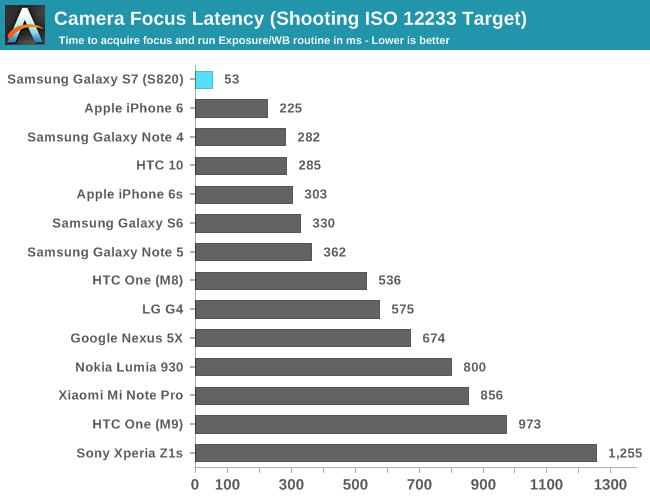
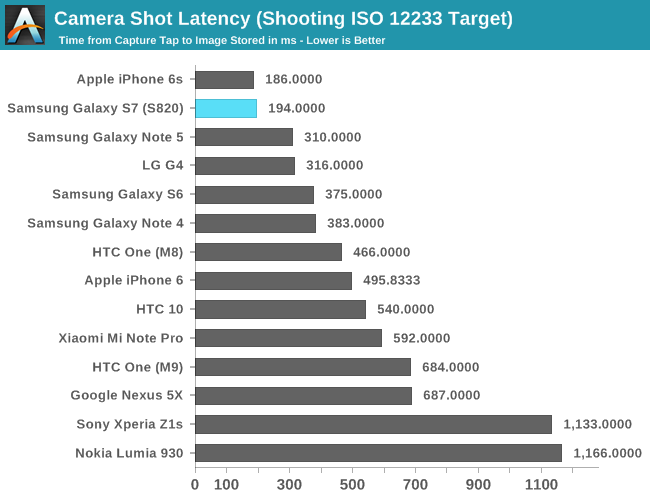
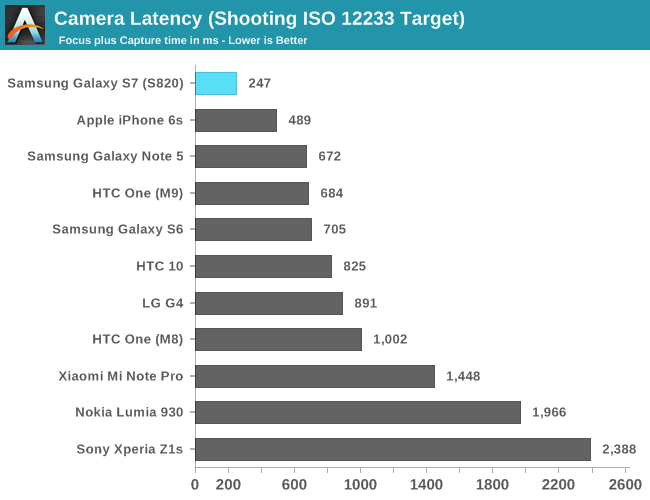
It’s probably not a surprise, but the Galaxy S7 is really, absurdly quick to take photos and focus. There is nothing out there that can realistically match the dual pixel AF system in the Galaxy S7, especially once you get into low light scenarios where traditional PDAF systems are overwhelmed by noise that can’t be easily canceled out. Samsung’s sheer prowess in semiconductor design and manufacture is really showing here, even in the best case.


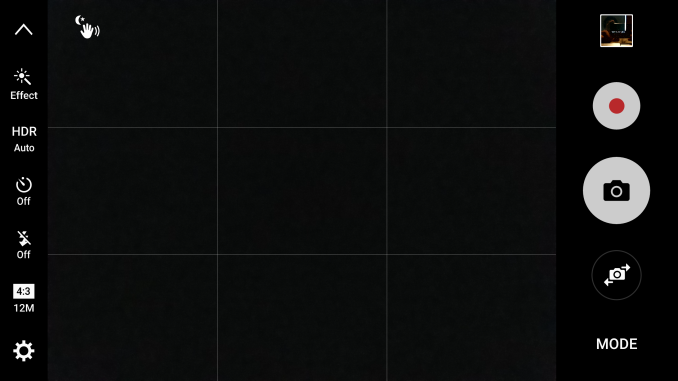
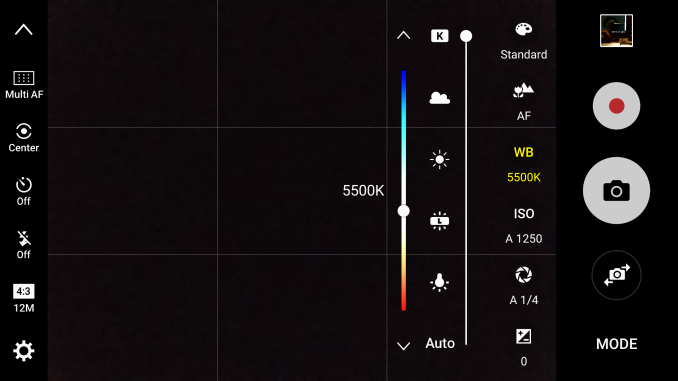
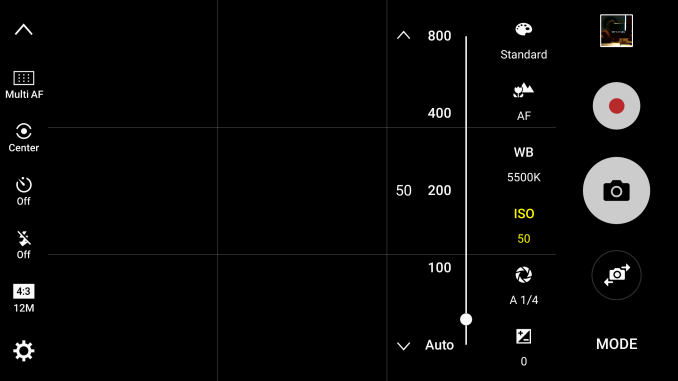








266 Comments
View All Comments
Ryan Smith - Tuesday, July 5, 2016 - link
I won't argue about our timeliness. It's something we're working on.However this is the first time I've ever heard anyone say that they felt we were clickbaity. Could you please elaborate? I personally abhor clickbait, so if we're coming across like that, then that would be extremely helpful feedback.
wolfemane - Wednesday, July 6, 2016 - link
click·baitˈklikbāt/
nouninformal
(on the Internet) content, especially that of a sensational or provocative nature, whose main purpose is to attract attention and draw visitors to a particular web page.
"these recent reports of the show's imminent demise are hyperbolic clickbait"
Shall i point out the retarded PROMOTED STORIES that sprout out. Every time an article is clicked, the page loads straight to them.
Full page adds with video that drag the site load down (specially on mobile)!
Ads that load several seconds after the main page loads very close to a link or relevant title. On slower systems or mobile this forces a miss click on those damn adds, and then the whole process of backing up and reloading all that shit again.
POP UP ADDS.
Yeah, you're site is now full of this stuff. I don't care about long review times on high demand items, or instant articles on low demand items. There are plenty of reviews out there for me to get the gist of a product. I LOVE the drama that spews forth in the comments and lately is the main reason I visit this site! But most of all I thoroughly enjoy every writer that posts an article to this site.
What I can not stand is for you to make a post in user comments about how you don't feel your site is clickbait. Do we need to create a thread on the forums and upload every click bait piece of trash that comes up on this site. If you are truly unaware, I think you would be appalled by what would be posted.
Michael Bay - Wednesday, July 6, 2016 - link
Nothing you described is a clickbait.Beautiful.
wolfemane - Wednesday, July 6, 2016 - link
By definition, everything I described is clickbait.Here it is again: (on the Internet) content, especially that of a sensational or provocative nature, whose main purpose is to attract attention and draw visitors to a particular web page.
Promoted Stories with ridiculous titles pulling you to 8 other websites. Clickbait? CHECK
Giant add on front page "DO YOU NV ME?" by Toshiba taking up a 3rd of the screen. Clickbait? CHECK
Ad by Rockspace claiming no one supports microsoft exchange like they do, loads 5 seconds after page finishes loading, and becomes header ad damn near forcing a miss click (and on mobile). Clickbait? CHECK
There's three right off the bat. Thanks for contributing!
erple2 - Wednesday, July 6, 2016 - link
I still don't see anything as clickbait that you've described. Poor advertising choices, yes (Ryan, please add me to the list of people that despises anything taboola related, and has concerns over the usability of the site as a result). But not clickbait.So far all of the promoted stories have been ... sketchy at best and pretty awful. As wolfemane correctly points out, they make the site seem more like sites that tend to be more clickbait like. Though that gawker is going g under, what does that mean for taboola?
Ryan Smith - Wednesday, July 6, 2016 - link
Hi wolfemane,Thanks for the feedback. To get right down to business, clickbait is typically a description reserved for editorial. i.e. do I make the title of this review "The Samsung GalaxyS7 and S7 edge Review: Part 2" or the "You won't believe this amazing Samsung Galaxy S7 review"? It goes without saying that we avoid the latter, as I don't believe sensationalism does anyone any favors. Descriptions need to be accurate, and content needs to be meaningful.
Advertising on the other hand is a different matter. As you may be aware, advertising is handled by our publisher, Purch. Which is to say that it's not AnandTech's content and editorial has no control over it.
That said, while I don't directly control advertising, the feedback is very useful all the same. All of this feedback gets passed on to Purch, and I have made them aware of your concerns. If you have any concerns about the advertising, please continue to provide feedback, and I'll be sure it gets passed on.
Impulses - Thursday, July 7, 2016 - link
I'm not seeing any of these full page ads, videos, or pop ups, like at all... I do browse mostly on mobile. The promoted stories I do see and I'd agree they're kinda beneath AT, but they don't take up any more space than a standard square ad would.Alexey291 - Thursday, July 7, 2016 - link
Thank you sir.KoolAidMan1 - Saturday, July 9, 2016 - link
Anandtech has consistently been the most thorough, honest tech website around. Reality doesn't match up with your personal brand bias so you call them out for being shills.Give me a break.
h0007h - Tuesday, July 5, 2016 - link
Did you compare the still image peformance between 820 and 8890 variants? It is said that in low light, images thaken by 8890 is much better than 820.